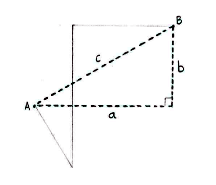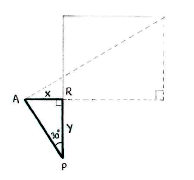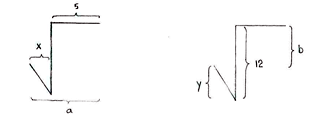Solution 4.2:9
From Förberedande kurs i matematik 1
m (Lösning 4.2:9 moved to Solution 4.2:9: Robot: moved page) |
|||
| Line 1: | Line 1: | ||
| - | + | If we introduce the dashed triangle below, the distance as the crow flies between | |
| - | < | + | <math>\text{A}</math> |
| - | + | and | |
| - | { | + | <math>\text{B}</math> |
| - | + | is equal to the triangle's hypotenuse, | |
| - | + | <math>c</math>. | |
| - | + | ||
| - | < | + | |
| - | + | ||
[[Image:4_2_9_1.gif|center]] | [[Image:4_2_9_1.gif|center]] | ||
| + | |||
| + | One way to determine the hypotenuse is to know the triangle's opposite and adjacent sides, since Pythagoras' theorem then gives | ||
| + | |||
| + | |||
| + | <math>c^{2}=a^{2}+b^{2}</math> | ||
| + | |||
| + | |||
| + | In turn, we can determine the opposite and adjacent by introducing another triangle | ||
| + | <math>\text{APR}</math>, where | ||
| + | <math>\text{R}</math> | ||
| + | is the point on the line | ||
| + | <math>\text{PQ}</math> | ||
| + | which the dashed triangle's side of length | ||
| + | <math>a</math> | ||
| + | cuts the line. | ||
| + | |||
[[Image:4_2_9_2.gif|center]] | [[Image:4_2_9_2.gif|center]] | ||
| + | |||
| + | Because we know that | ||
| + | <math>\text{AP}=\text{4}</math> | ||
| + | and the angle at P, simple trigonometry shows that | ||
| + | <math>x</math> | ||
| + | and | ||
| + | <math>y</math> | ||
| + | are given by | ||
| + | |||
| + | |||
| + | <math>\begin{align} | ||
| + | & x=4\sin 30^{\circ }=4\centerdot \frac{1}{2}=2, \\ | ||
| + | & y=4\cos 30^{\circ }=4\centerdot \frac{\sqrt{3}}{2}=2\sqrt{3} \\ | ||
| + | \end{align}</math> | ||
| + | |||
| + | |||
| + | We can now start to look for the solution. Since | ||
| + | <math>x</math> | ||
| + | and | ||
| + | <math>y</math> | ||
| + | have been calculated, we can determine | ||
| + | <math>a</math> | ||
| + | and b by considering the horizontal and vertical distances in the figure. | ||
| + | |||
| + | |||
[[Image:4_2_9_3.gif|center]] | [[Image:4_2_9_3.gif|center]] | ||
| + | |||
| + | <math>a=x+5=2+5=7</math> | ||
| + | |||
| + | <math>b=12-y=12-2\sqrt{3}</math> | ||
| + | |||
| + | |||
| + | With a and | ||
| + | <math>b</math> | ||
| + | given, Pythagoras' theorem leads to | ||
| + | |||
| + | |||
| + | <math>\begin{align} | ||
| + | & c=\sqrt{a^{2}+b^{2}}=\sqrt{7^{2}+\left( 12-2\sqrt{3} \right)^{2}} \\ | ||
| + | & =\sqrt{49+\left( 12^{2}-2\centerdot 12\centerdot 2\sqrt{3}+\left( 2\sqrt{3} \right)^{2} \right)} \\ | ||
| + | & =\sqrt{205-38\sqrt{3}}\quad \approx \quad 11.0\quad \text{km}\text{.} \\ | ||
| + | \end{align}</math> | ||
Revision as of 09:58, 29 September 2008
If we introduce the dashed triangle below, the distance as the crow flies between \displaystyle \text{A} and \displaystyle \text{B} is equal to the triangle's hypotenuse, \displaystyle c.
One way to determine the hypotenuse is to know the triangle's opposite and adjacent sides, since Pythagoras' theorem then gives
\displaystyle c^{2}=a^{2}+b^{2}
In turn, we can determine the opposite and adjacent by introducing another triangle
\displaystyle \text{APR}, where
\displaystyle \text{R}
is the point on the line
\displaystyle \text{PQ}
which the dashed triangle's side of length
\displaystyle a
cuts the line.
Because we know that \displaystyle \text{AP}=\text{4} and the angle at P, simple trigonometry shows that \displaystyle x and \displaystyle y are given by
\displaystyle \begin{align}
& x=4\sin 30^{\circ }=4\centerdot \frac{1}{2}=2, \\
& y=4\cos 30^{\circ }=4\centerdot \frac{\sqrt{3}}{2}=2\sqrt{3} \\
\end{align}
We can now start to look for the solution. Since
\displaystyle x
and
\displaystyle y
have been calculated, we can determine
\displaystyle a
and b by considering the horizontal and vertical distances in the figure.
\displaystyle a=x+5=2+5=7
\displaystyle b=12-y=12-2\sqrt{3}
With a and
\displaystyle b
given, Pythagoras' theorem leads to
\displaystyle \begin{align}
& c=\sqrt{a^{2}+b^{2}}=\sqrt{7^{2}+\left( 12-2\sqrt{3} \right)^{2}} \\
& =\sqrt{49+\left( 12^{2}-2\centerdot 12\centerdot 2\sqrt{3}+\left( 2\sqrt{3} \right)^{2} \right)} \\
& =\sqrt{205-38\sqrt{3}}\quad \approx \quad 11.0\quad \text{km}\text{.} \\
\end{align}



